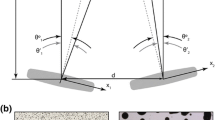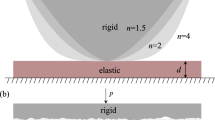Abstract
The “Contact Mechanics Challenge” posed to the tribology community by Müser and Dapp in 2015 detailed a 100 µm × 100 µm randomly rough surface with a root-mean-square gradient of unity, \({\bar{\text{g}}} = 1\). Many surfaces, both natural and synthetic, can be described as randomly rough, but rarely with a root-mean-square gradient as steep as \({\bar{\text{g}}} = 1\). The selection of such a challenging surface parameter was intentional, but potentially limiting for broad comparisons across existing models and theories which may be limited by small-slope approximations. In this manuscript, the root-mean-square gradients (\({\bar{\text{g}}}\)) of the “Contact Mechanics Challenge” surface were produced on 1000 × scaled models such that there were three different surfaces for study with \({\bar{\text{g}}} = \, 0.2, \, 0.5\), and 1. In situ measurements of the real area of contact and contact area distributions were performed using frustrated total internal reflectance along with surface deformation measurements performed using digital image correlation. These optical in situ experiments used the scaled 3D-printed rough surfaces that were loaded into contact with smooth, flat, and elastic samples that were made from unfilled PDMS: (10:1) E* = 2.1 MPa Δγ = 4 mJ/m2; (20:1) E* = 0.75 MPa Δγ = 3 mJ/m2; (30:1) E* = 0.24 MPa Δγ = 2 mJ/m2. All of the loading was performed using a uniaxial load frame under force control. A Green’s function molecular dynamics simulation assuming the small-slope approximation was compared to all experimental data. These measurements reveal that decreasing root-mean-square gradient noticeably increases real area of contact area under conditions of “equal” applied load, but variations in the root-mean-square gradient did not significantly alter the contact patch geometry under conditions of nearly equal real area of contact. Including \({\bar{\text{g}}}\) in the reduced pressure (\(p = P /(E*{\bar{\text{g}}})\)) reduced the root-mean-square error between the simulation (\({\bar{\text{g}}} = 1\)) and all experimental data for the relative area of contact as a function of reduced pressure over the entire range of surfaces, materials, and loads tested.





Similar content being viewed by others
References
Müser, M.H., Dapp, W.B.: The contact mechanics challenge: problem definition. arXiv:1512.02403 (2015)
Yastrebov, V.A., Anciaux, G., Molinari, J.-F.: From infinitesimal to full contact between rough surfaces: evolution of the contact area. Int. J. Solids Struct. 52, 83–102 (2015). https://doi.org/10.1016/j.ijsolstr.2014.09.019
Campañá, C., Müser, M.H.: Contact mechanics of real vs. randomly rough surfaces: a green’s function molecular dynamics study. Europhys. Lett. 77, 38005 (2007). https://doi.org/10.1209/0295-5075/77/38005
Yang, C., Persson, B.N.J.: Contact mechanics: contact area and interfacial separation from small contact to full contact. J. Phys. Condens. Matter 20, 215214 (2008). https://doi.org/10.1088/0953-8984/20/21/215214
Putignano, C., Afferrante, L., Carbone, G., Demelio, G.: The influence of the statistical properties of self-affine surfaces in elastic contacts: a numerical investigation. J. Mech. Phys. Solids 60, 973–982 (2012). https://doi.org/10.1016/j.jmps.2012.01.006
Campañá, C., Müser, M.H., Robbins, M.O.: Elastic contact between self-affine surfaces: comparison of numerical stress and contact correlation functions with analytic predictions. J. Phys. Condens. Matter 20, 354013 (2008). https://doi.org/10.1088/0953-8984/20/35/354013
Pastewka, L., Robbins, M.O.: Contact between rough surfaces and a criterion for macroscopic adhesion. Proc. Natl. Acad. Sci. 111, 3298–3303 (2014). https://doi.org/10.1073/pnas.1320846111
Müser, M.H.: A dimensionless measure for adhesion and effects of the range of adhesion in contacts of nominally flat surfaces. Tribol. Int. 100, 41–47 (2015). https://doi.org/10.1016/j.triboint.2015.11.010
Müser, M.H., Dapp, W., Bugnicourt, R., Sainsot, P., Lesaffre, N., Lubrecht, T., Persson, B., Harris, K., Bennett, A., Schulze, K., Rohde, S., Ifju, P., Sawyer, G., Angelini, T., Esfahani, H., Kadkhodaei, M., Akbarzadeh, S., Wu, J.-H., Vorlaufer, G., Vernes, A., Solhjoo, S., Vakis, A., Jackson, R., Xu, Y., Streator, J., Rostami, A., Dini, D., Medina, S., Carbone, G., Bottiglione, F., Luciano, A., Monti, J., Pastewka, L., Robbins, M., Greenwood, J.: Meeting the contact-mechanics challenge. Tribol. Lett. 65, 118 (2017)
Mandelbrot, B.B.: The Fractal Geometry of Nature. Henry Holt and Company, New York (1982)
Mandelbrot, B.B.: Self-affine fractals and fractal dimension. Phys. Scr. 32, 257–260 (1985). https://doi.org/10.1088/0031-8949/32/4/001
Jacobs, T.D.B., Junge, T., Pastewka, L.: Quantitative characterization of surface topography using spectral analysis. Surf. Topogr. Metrol. Prop. 5, 13001 (2017). https://doi.org/10.1088/2051-672X/aa51f8
Bennett, A.I., Harris, K.L., Schulze, K.D., Uruena, J.M., Pitenis, A.A., Müser, M.H., Angelini, T.E., Sawyer, W.G.: Contact area measurements of randomly rough surfaces. Tribol. Lett. 65, 134 (2017)
Rohde, S.E., Bennett, A.I., Harris, K.L., Ifju, P.G., Angelini, T.E., Sawyer, W.G.: Measuring contact mechanics deformation using DIC through a transparent medium. Exp. Mech. 9, 1445–1455 (2017)
Bennett, A.I., Rohde, S., Harris, K.L., Schulze, K.D., Manuel, J., Pitenis, A.A., Ifju, P., Angelini, T.E., Müser, M.H., Sawyer, W.G.: Deformation measurements of randomly rough surfaces. Tribol. Lett. 65, 123 (2017)
Sutton, M., Wolters, W., Peters, W., Ranson, W., McNeill, S.: Determination of displacements using an improved digital correlation method. Image Vis. Comput. 1, 133–139 (1983). https://doi.org/10.1016/0262-8856(83)90064-1
Chu, T.C., Ranson, W.F., Sutton, M.A.: Applications of digital-image-correlation techniques to experimental mechanics. Exp. Mech. 25, 232–244 (1985). https://doi.org/10.1007/BF02325092
Luo, P.F., Chao, Y.J., Sutton, M.A., Peters, W.H.: Accurate measurement of three-dimensional deformations in deformable and rigid bodies using computer vision. Exp. Mech. 33, 123–132 (1993). https://doi.org/10.1007/BF02322488
Author information
Authors and Affiliations
Corresponding author
Additional information
This article is part of the Topical Collection on Special Issue: The Contact Mechanics Challenge.
Rights and permissions
About this article
Cite this article
McGhee, A.J., Pitenis, A.A., Bennett, A.I. et al. Contact and Deformation of Randomly Rough Surfaces with Varying Root-Mean-Square Gradient. Tribol Lett 65, 157 (2017). https://doi.org/10.1007/s11249-017-0942-5
Published:
DOI: https://doi.org/10.1007/s11249-017-0942-5




